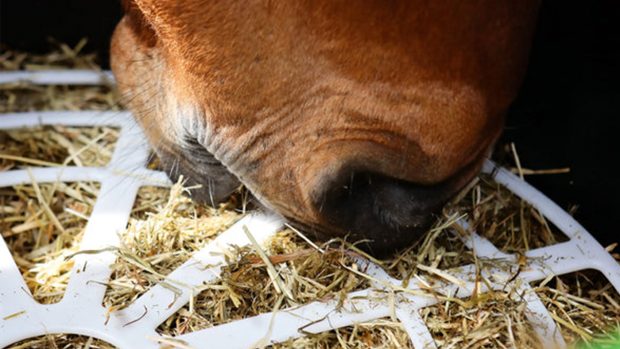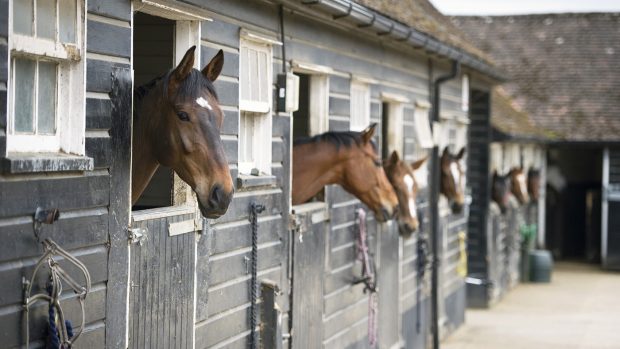What's the best approach to take when feeding an injured competition horse on box rest? H&H speaks to top nutritionists to find out
It’s the middle of the competition season and your horse picks up an injury. Hopefully, the injury is fairly minor and he’ll only need a limited period of box rest, but what should you do about feeding him?
“As with any injury, veterinary treatment and care will be the first port of call, followed closely by nutrition — your horse’s diet plays a major role in aiding the recovery process,” says Saracen nutritionist Lizzie Drury.
“Feeding an injured horse not only serves to meet his maintenance requirements, but it also provides additional support for the healing process.
“The main objective is to make the transition from the competition diet to the recovery diet as smooth as possible to avoid any potential digestive upsets.”
Dietary changes
A fit competition horse who is suddenly confined to a stable will no longer require high amounts of energy from his feed, so a decrease in his concentrates ration should be made straightaway.
“The day you reduce your horse’s exercise you should also reduce their calorie intake,” says Dodson & Horrell’s Chloe Casalis de Pury. “Maintaining high feed intakes, particularly of competition feeds, in a horse out of work is a recipe for weight gain, excitability or bad behaviour, and carries a risk of worsening the original injury.
“A general rule of thumb is to reduce the hard feed ration by 50%. So if your horse normally gets four scoops of hard feed a day, cut this down to two scoops a day. This will reduce the chance of your horse ‘tying-up’ on return to work if the injury is short-lived, or becoming obese if the injury takes longer to heal.”
Swapping high-concentrate feeds for lower-energy options is also to be considered.
“Assuming the horse was on traditional cereal-based competition feed prior to injury, this will need to be replaced with a lower energy alternative,” says Joanna Palmer from Allen & Page. “Switching to a high-fibre bucket feed that is low in starch and sugar and balanced with vitamins and minerals is ideal for a horse on box rest.”
Introducing new feeds to a horse’s diet should be done gradually.
“You should take at least four days, and up to 10 days, to introduce new feed, and that includes new types of forage,” advises Nicola Tyler from TopSpec. “When changing feed, I suggest 75% old feed to 25% new feed on the first day, on the second day 50% of each one, on the third day 75% new and 25% old, and on the fourth day 100% new.”
When changing a diet quickly, a digestive enhancer — which can be introduced straight away — can help the bacteria in the gut adapt to the new diet and reduce the risk of upsets occurring.
“The use of digestive aids such as a probiotic or yeast is recommended when feeding antibiotics or other drugs, all of which could have a negative impact on the health of the [gut] microflora,” says Lizzie.
Pre- and probiotics can also help the horse’s immune system.
“They are brilliant at bumping along the villi that line the intestinal tract and stimulating the immune system,” explains Nicola Tyler. “They also help move everything through the digestive system, meaning less likelihood of an impaction colic.”
Feeding forage
When horses are stabled for long periods, feeding ad-lib forage is ideal for supporting digestive health and helps to fulfil the horse’s need to chew.
“Saliva helps to neutralise stomach acid and horses only produce saliva when they chew,” says Sarah Nelson from Spillers.
“Give plenty of hay or haylage at a minimum of 2% of your horse’s bodyweight [10kg of hay per 24 hours for a 500kg horse],” advises Chloe. “Providing moist fibre such as handpicked grass or soaked un-molassed sugar beet will promote normal digestive function.”
For horses fed haylage, this could be replaced with good quality hay.
“It will enable you to feed it more ad lib, and feeding forage ad lib is going to help them settle in the stable,” says Nicola Tyler. “You could also try a molassed hay-replacer type chop such as half-straw and half alfalfa.”
Jane Buchan from Baileys adds: “Correct nutrition can actually aid healing by providing the nutrients required for tissue development. Amino acids are the building blocks of protein and are components of all body cells. These are particularly important for soft tissue repair, such as of muscles and tendons.
“With the exception of alfalfa, forages tend not to contain sufficient quality protein, so feeding a balancer should ensure the horse doesn’t go short.”
Vitamins and minerals are also integral in cell and tissue structure, which is vital for the healing process. A balancer should also supply sufficient amounts of these.
“Another easy option is to give vitamins and minerals as a molassed, broad-spectrum lick which allows free access and keeps horses occupied.”
Some horses may need a calmer while on box rest to keep them relaxed.
“You can feed calmers as a supplement or as an instant shot from a syringe,” says Liz Driver from Blue Chip.
“Effective calmers contain magnesium and L-tryptophan, which is one of the building blocks of serotonin production. Serotonin is a hormone produced in the brain that helps to keep the horse in a settled and relaxed state.”
Getting going again
Once your horse has been given the go ahead to start work again, it can be tempting to put him straight back on a performance feed, but rehabilitation needs to be slow, and any dietary changes should also be gradual.
“Most horses will benefit from staying on either their balancer, convalescent feed or a balance of the two during the first three to four weeks of early training,” says Chloe.
“Feed according to your horse’s body condition score; any excess weight gained during rest must be shed during the early stages of recovery to avoid exacerbating the healing injury. Levels of micronutrients, particularly essential amino acids such as lysine, are especially important at this stage, as your horse rebuilds any lost muscle and strengthens tendons and ligaments.”
These amino acids can be provided by a high quality balancer or performance feed, which your horse should gradually move onto as their workload increases.
Combating boredom
Boredom is a common problem during periods of box rest.
“Stable toys and alternative forage sources such as fibre cubes in boredom balls help to keep the horse’s mind active and satisfy his need to chew,” says Jane.
Being stabled for longer periods can also cause respiratory problems.
“If respiratory health is a concern, consider soaking or steaming your hay or gradually changing from hay to haylage,” says Sarah. “Soaking hay for 10 minutes causes the majority of spores to swell so that they are ingested rather than inhaled. Soaked hay should be fed immediately as the spores may become airborne again once dried.”
Like this? You might also enjoy reading these:
The 10 golden rules of feeding horses
H&H Feed Week: the right diet to help prevent horses tying up
H&H Feed Week: Test your knowledge of the horse’s digestive system
Ensuring your horse takes on an adequate amount of water is key.
“An increase in dry matter could potentially lead to impaction colic, so ensuring adequate water intake will be important,” says Lizzie. “Fluid intake can be promoted by soaking hay and feeding carrots and soaked sugar beet.”
H&H 11 February 2016





